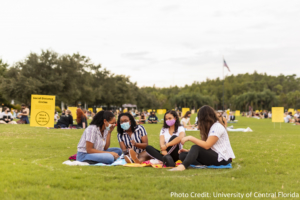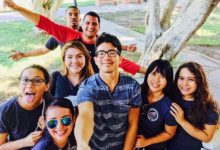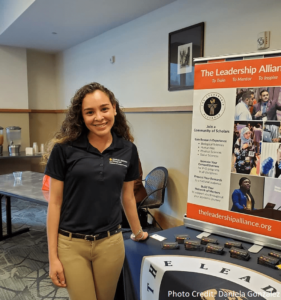Staying connected with students during COVID-19
Those connections matter now more than ever.
But how can these universities maintain them amid a raging pandemic, social distancing requirements, and the move to remote learning? And how can they ensure that the pandemic won’t erase the progress they’ve made on access and diversity?, we asked.
Those are major concerns at U Albany, said President Rodríguez, since many of the university’s students hail from Brooklyn or Queens or Long Island and could opt to stay closer to home and not come back to the institution.
To address some of those challenges, U Albany is reaching out to students regularly. Staff have been calling students to see how they are doing and what they need. Meanwhile, President Rodríguez has phoned and written letters to a number of EOP students who’ve lost family members to COVID-19 to let them know that they’re part of the university community, that people at the university care about them and are here to help, he said.
The university has also raised nearly $300,000 for the student emergency fund and sent checks generally ranging from $100 to $800 to over 600 students who are struggling to meet basic needs, like buying groceries or paying for rent or utilities.
Realizing early on that access to technology would be an issue for many students, the university repackaged the computers in the computer lab and the library, and sent them to 200 or so to students, U Albany Provost Carol Kim recalled.
Such actions might not seem like much, but they’re critically important and can have a major impact, said Rodríguez, who noted that small gestures “signal to students that we care.”
 UCF has taken similar steps, but those strategies may only be part of the solution, President Cartwright said, noting that it could be some time before all classes fully resume in person. While he admitted he doesn’t have all the answers, he said his university is thinking about digital tools and nontraditional ways of building community. Academia might emulate the gaming community, he suggested, which has built virtual communities all over the world, using tools like Discord, a text and voice application which lets users create their own communities and converse with each other. “It’s a different way of thinking about community,” said Cartwright, who believes academic institutions could well find new ways to connect with students as a result of COVID-19.
UCF has taken similar steps, but those strategies may only be part of the solution, President Cartwright said, noting that it could be some time before all classes fully resume in person. While he admitted he doesn’t have all the answers, he said his university is thinking about digital tools and nontraditional ways of building community. Academia might emulate the gaming community, he suggested, which has built virtual communities all over the world, using tools like Discord, a text and voice application which lets users create their own communities and converse with each other. “It’s a different way of thinking about community,” said Cartwright, who believes academic institutions could well find new ways to connect with students as a result of COVID-19.
In the meantime, both he and Rodríguez said they’re taking things day by day. They stressed that the work of building a diverse and inclusive campus culture is ongoing and never-ending. While they hope the U.S. and American universities may be reaching an inflection point on diversity, equity, and inclusion — everyone is talking about these issues and there’s not a university out there right now that will tell you they’re not committed to them, Rodríguez noted — they say talk is cheap.
Ultimately, they agreed, success can only be built on the recognition that diversity isn’t a one-off or a fad, but our country’s demographic future.





 Daniela González is one of them. A first-generation rising senior from Colombia, González came to the U.S. to study psychology. She thought attending Valencia College, a local community college in Orlando, was her only option — for financial reasons and because she spoke little English when she arrived — until the DirectConnect program (and Kimberly Ortiz, her DirectConnect success coach) opened a door to UCF. Gonzalez credits Ortiz, who is herself Hispanic and a UCF grad, with pushing her to pursue her dream of attending a four-year college and helping her chart a successful path to a degree. “I never thought that I will be college material. I never thought I was good enough to succeed because of my accent,” but Ortiz “was an inspiration to me because she also came to this country and had to learn English and was somebody I could relate to. Having her as a coach, it was like, if she could do it, I can do it, too,” said González, who plans to pursue a Ph.D. in industrial and organizational psychology.
Daniela González is one of them. A first-generation rising senior from Colombia, González came to the U.S. to study psychology. She thought attending Valencia College, a local community college in Orlando, was her only option — for financial reasons and because she spoke little English when she arrived — until the DirectConnect program (and Kimberly Ortiz, her DirectConnect success coach) opened a door to UCF. Gonzalez credits Ortiz, who is herself Hispanic and a UCF grad, with pushing her to pursue her dream of attending a four-year college and helping her chart a successful path to a degree. “I never thought that I will be college material. I never thought I was good enough to succeed because of my accent,” but Ortiz “was an inspiration to me because she also came to this country and had to learn English and was somebody I could relate to. Having her as a coach, it was like, if she could do it, I can do it, too,” said González, who plans to pursue a Ph.D. in industrial and organizational psychology. UCF has taken similar steps, but those strategies may only be part of the solution, President Cartwright said, noting that it could be some time before all classes fully resume in person. While he admitted he doesn’t have all the answers, he said his university is thinking about digital tools and nontraditional ways of building community. Academia might emulate the gaming community, he suggested, which has built virtual communities all over the world, using tools like Discord, a text and voice application which lets users create their own communities and converse with each other. “It’s a different way of thinking about community,” said Cartwright, who believes academic institutions could well find new ways to connect with students as a result of COVID-19.
UCF has taken similar steps, but those strategies may only be part of the solution, President Cartwright said, noting that it could be some time before all classes fully resume in person. While he admitted he doesn’t have all the answers, he said his university is thinking about digital tools and nontraditional ways of building community. Academia might emulate the gaming community, he suggested, which has built virtual communities all over the world, using tools like Discord, a text and voice application which lets users create their own communities and converse with each other. “It’s a different way of thinking about community,” said Cartwright, who believes academic institutions could well find new ways to connect with students as a result of COVID-19.